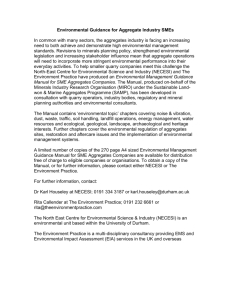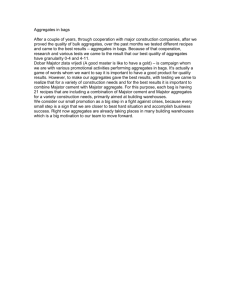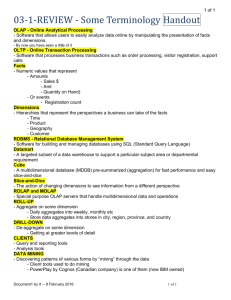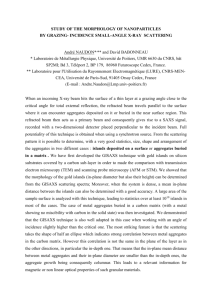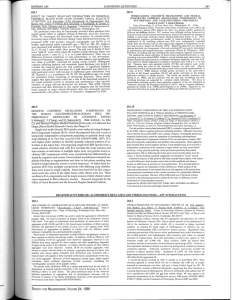Fabrication of Water-Soluble Gold Nanoparticle Aggregates by
advertisement
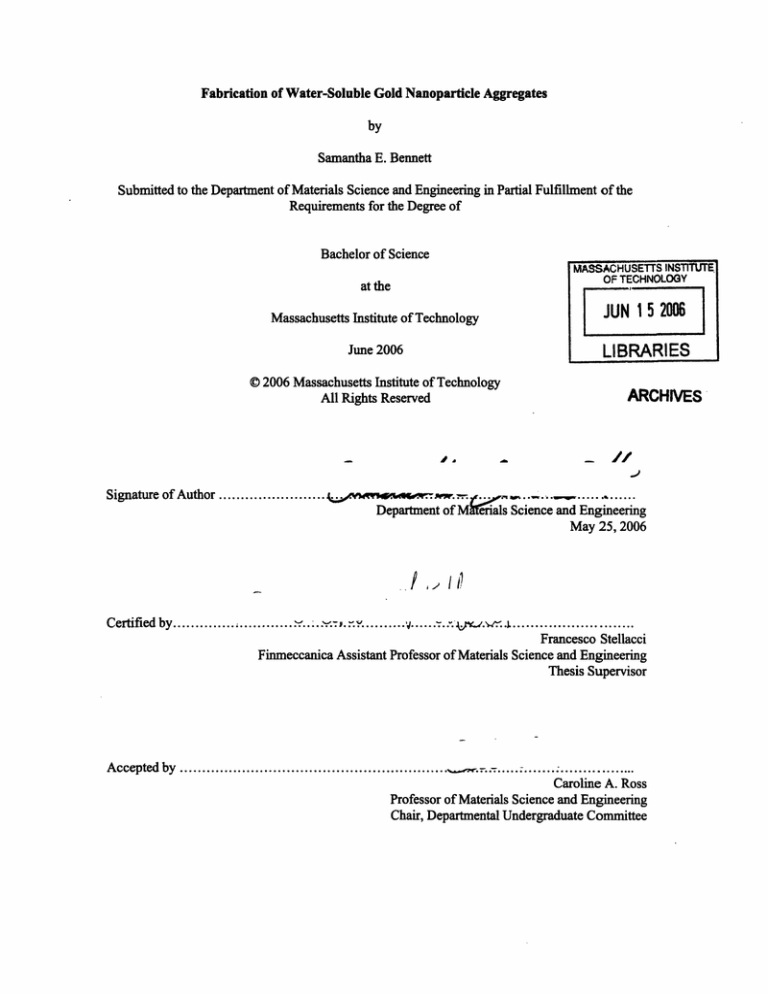
Fabrication of Water-Soluble Gold Nanoparticle Aggregates by Samantha E. Bennett Submitted to the Department of Materials Science and Engineering in Partial Fulfillment of the Requirements for the Degree of Bachelor of Science INSTITUTE MASSACHUSE OF TECHNOLOGY at the Massachusetts Institute of Technology JUN 15 2006 June 2006 LIBRARIES © 2006 Massachusetts Institute of Technology All Rights Reserved -_ / A. Signature of Author ................................- / ............. ... Department of M erials Science and Engineering May 25, 2006 , Certified by.......................... ARCHIVES I/? ................... v . .. ........................... Francesco Stellacci Finmeccanica Assistant Professor of Materials Science and Engineering Thesis Supervisor Accepted by ................... ...................................... .......................... Caroline A. Ross Professor of Materials Science and Engineering Chair, Departmental Undergraduate Committee FABRICATION OF WATER-SOLUBLE GOLD NANOPARTICLE AGGREGATES by SAMANTHA E. BENNETT Submitted to the Department of Materials Science and Engineering on May 25, 2006 in Partial Fulfillment of the Requirements for the Degree of Bachelor of Science in Materials Science and Engineering ABSTRACT Mixed monolayer protected gold nanoparticles were linked using octanedithiol to form aggregates containing hundreds of nanoparticles. These aggregates are an interesting material, posing potential applications in the fields of chemistry, biology and materials science. This study examined the dependence of aggregate size and morphology on temperature of formation, using AFM and TEM imaging. The aggregates formed at 70°C averaged 105nm in width, as compared to 70nm for the room temperature aggregates. The TEM images showed increased density for the 70°C aggregates. In a further study, the room temperature aggregates were functionalized through a place exchange reaction with 1 -mercapto-undecane- l-sodiumsulfonate (MUS), a thiolated ligand with a polar head group. A two-phase test of the water-solubility indicated that the aggregates were fully soluble. TEM images showed a slight increase in size, though similar morphology to the insoluble aggregates. The ability to induce water solubility in the aggregates opens up many potential applications in the field of bionanomaterials. Thesis Supervisor: Francesco Stellacci Title: Finmeccanica Assistant Professor of Materials Science and Engineering 2 Table of Contents Abstract ......................................................................... List of Figures . ....................................... ............................................................. 2 4 Acknowledgements ..................................................................... 5 Chapter 1. Introductory Remarks ........................................................ 6 Chapter 2. Background Information ........................................ ............................. 8 Chapter 3. Experimental Methods 3.1 Materials....................................................................................................... ................... 3.2 Synthesisof GoldNanoparticles. 11 1..................... 11 12 ................................ 3.3 Synthesis of Gold Nanoparticle Aggregates.............................. ................. 13 3.4 Synthesis of Water-Soluble Gold Nanoparticle Aggregates ............ 3.5 Characterizationof GoldNanoparticleAggregates............................................ 13 3.6 Water-SolubilityTest of GoldNanoparticleAggregates...................................... 14 Chapter 4. Results and Discussion 4.1 NanoparticleAggregateSizes Evaluatedvia AFM Imaging ................................. 15 4.2 NanoparticleAggregateSizes Evaluatedvia TEMImaging................................ 16 4.3 Water-Solubilityof MUS-FunctionalizedNanoparticleAggregates........................19 4.4 Water-SolubleNanoparticleAggregateSizes Evaluatedvia TEMImaging............. 19 Chapter 5. Conclusions and Future Work ........................................ ................ References ..................................................................................................... 3 21 23 List of Figures Figure 1. Schematic of mixed-ligand nanoparticle showing rippled morphology ........... 7 10 Figure 2. TEM image of nanoparticle aggregates .............................................. 0 17 and 70 C .............. temperature at room Figure 3. AFM images of aggregates formed Figure 4. TEM images of aggregates formed at room temperature and 70C .............. 18 19 Figure 5. Photographs of two-phase water-solubility experiment ..................... 20 Figure 6. TEM images of water-soluble aggregates........................................... 4 ACKNOWLEDGEMENTS My sincerest thanks go to Prof. Francesco Stellacci for his support and guidance of this research. Thanks go as well to all of the members of Professor Stellacci's research group for their invaluable assistance. I am especially indebted to Jin-Mi Jung for help with atomic force microscopy, and Dr. Oktay Uzun for his close supervision of this project. The supportive and helpful nature of this group reaffirms my respect and affection for the undergraduate program in the Department of Materials Science and Engineering at MIT. 5 Chapter 1. Introductory Remarks The study of metal-core nanoparticles has led to the discovery of their sizedependent electronic, magnetic and optical properties'. Their use in catalytic and biomedical applications depends on our ability to stabilize and isolate the nanoparticles. Using phosphine-stabilization of Au55 clusters, Schmid et al examined the properties of quantum-dot particles for the first time2 . Subsequent work established the Brust-Schiffrin model as the standard for stabilization of metal nanoparticles3 . This technique provides a simple method using a self-assembled monolayer of thiolated ligands on the nanoparticle surface to prevent the particles from coalescing. These monolayer-protected metal nanoparticles (MPMNs) can be repeatedly isolated and redissolved in organic solvents without showing decomposition or irreversible aggregation4. Self-assembled monolayers (SAMs) of thiolated ligands provide an easy and convenient method by which to control the interfacial properties of metal nanoparticles5 . Recent work using a mixture of thiolated ligands has shown phase separation resulting in ordered domains. Using two types of thiols, "ripples" are observed that encircle the nanoparticle, with widths as small as 5A6 [Figure 1]. These and other novel MPMNs have potential applications as nanoscale electronic devices, multifunctional catalysts, and chemical sensors7 . Further functionalization of the SAMs can be realized through place exchange reactions of the thiolated ligands8 . 6 Figure 1. Schematic showing phase separated ligands on a rippled nanoparticle6 . The assembly of nanoparticles into controlled sizes and shapes is essential for the investigation of nanoscale structure-property relations. MPMN assembly has been studied via methods such as polymer-based molecular recognition9 , hydrogen bondingl° , and through the use of multidentate thioethers". The formation of MPMN aggregates using dithiol cross-linking 2 provides a reproducible method of spherical aggregate formation 3 . Now that a means for synthesizing aggregates has been developed, further application of the technology depends on practical examination of the environments in which the aggregates will be used. Bionanomaterials applications demand water-solubility of the nanoparticle aggregates in order to function within aqueous biological environments. Recent work has shown that Tiopronin and coenzyme-A can be used to induce solubility of MPMNs7 in water. The current study examines whether a simple place exchange reaction using a thiolated ligand with a polar end-group will produce water-solubility. Building on the reproducible Schiffrin method for MPMN formation, and the straightforward use of dithiols for aggregate formation, this work proposes an equally easy method for making water-soluble gold nanoparticle aggregates. 7 Chapter 2. Background Information The keen interest surrounding nanoparticles in modem materials science stems from the unique size-dependent properties that they exhibit. With diameters of 1-1Onm on average, these particles behave differently from both bulk and atomic-scale materials. Current applications for nanoparticles range from magnetic storage, disease therapy, photography, catalysis, and even cosmetics. Potential applications for this class of material are extremely broad, including such areas as novel nanoelectronic devices based on single electron tunneling through nanoparticle arrays. Gold and other coinage metals are often used in these applications due to the high reactivity of their surfaces, which can form stable bonds with passivating organic molecules, such as alkanethiols14 . A unique characteristic of nanoscale materials is the large percentage of their constituent atoms that are found at the surface. By altering the surface environment, one can see radical changes in the physical properties of the material. The formation of bonds between the surface atoms of gold nanoparticles and organic molecules lowers the free energy of the metal-environment interface. Through this thermodynamically driven process, SAMs form on the surface of gold nanoparticles. The SAMs used in the current study are made of thiolated ligands, each molecule possessing three basic components: a head group, showing a specific affinity for bonding to the surface, a carbon backbone, and an end group that determines the surface and interfacial characteristics of the nanoparticle. In addition to stabilizing the gold nanoparticles, the SAM lends its unique properties to the system 5 . 8 The basic method for formation of MPMNs via either one or two-phase synthesis was developed by Brust and Schiffrin in 1994. In the two-phase version, aqueous gold salt (HauCl4) is combined with the phase transfer reagent, tetraoctylammonium bromide, in an organic solvent such as toluene. The thiolated ligands are added that will bond to the gold and form the SAM. Sodium borohydride (NaBH4 ) functions as a reducing agent and the gold ions combine with the ligands in the organic phase. Equations 1 and 2 describe the reactions . AuCL4-(toluene) + RSH (-AuSR-)(polymer) (-AulSR-) + BH4 AUxSRy equation (1) equation (2) The gold clusters grow until their surfaces are wholly covered in ligands. In practice, immersion time is inversely proportional to the concentration of the ligands in solution. Thus, the size of the gold clusters, as well as the time for SAM formation can be controlled using the ligand concentration3 . The Schiffrin model can be modified to create multi-ligand SAMs8 ' 5. Organization of the ligands into ordered domains can be induced by using ligands with hydrophobic and hydrophilic head groups, respectively. These "rippled" nanoparticles show ordered domains as small as 5A, and demonstrate useful properties such as avoidance of non-specific adsorption of proteins6 . Rippled nanoparticles can be induced to form aggregates via a place-exchange reaction with a dithiol linker molecule13 [Figure 2]. The nanoparticles are combined with the dithiol molecules dissolved in a nonpolar solvent such as tetrahydrofuran (THF). In order to support ordered phase separation of ligand domains, defects exist at opposite poles, showing high reactivity. It is at these sites that the dithiol molecules place 9 exchange, linking the nanoparticles to form aggregates6 . Evidence of aggregation can be seen from a redshift in optical absorption spectra, indicating the formation of nanoparticle aggregates. r- T_ Figure 2. TEM image showing nanoparticle aggregates. The nanoparticle aggregates formed via this process are readily soluble in nonpolar solvents, owing to the nature of the thiolated ligands; however, water-solubility is not originally achieved. Areas of research such as bionanotechnology would profit from water-soluble aggregates for drug delivery and contrast agents. Initial results of this study suggest that water-solubility can be achieved via a place exchange reaction between the rippled nanoparticle ligands and thiolated ligands with a polar head group. 10 Chapter 3. Experimental Methods 3.1 Materials The chemicals used in the synthesis of gold nanoparticles were hydrogen tetrachloroaurate trihydrate, sodium borohydride, tetraoctylammonium bromide, and thiolated ligands (nonanethiol (CH3-(CH2) 10 -SH, NT), methylbenzenethiol (CH3-( C6H4 )SH, MBT)). Octanedithiol (SH-(CH 2) 8 -SH, ODT) was used to form the nanoparticle aggregates. The solvents used in the nanoparticle synthesis, aggregate synthesis, sample preparations, and characterizations were toluene, methanol, tetrahydrofuran (THF), and chloroform. . All chemicals were purchased from Sigma-Aldrich and used as received. I -mercapto-undecane-l-sodiumsulfonate (MUS) was synthesized in the laboratory. 3.2 Synthesisof GoldNanoparticles The gold nanoparticles were synthesized using Schiffrin's method of two-phase synthesis. 0.9mmol of hydrogen tetrachloroaurate (355 mg) were dissolved in 50 mL of deionized (DI) water, and the solution was stirred for ten minutes. 2mmol of the phase transfer reagent, tetraoctylammonium bromide (1903 mg), were added to toluene. After stirring for ten minutes, 0.6mmol of NT (113 mL) and 0.3mmol of MBT (35mL) were introduced, and the solution was stirred for a further ten minutes. A solution of 500mg of sodium borohydride in 50 mL of DI water was prepared and slowly added to the goldthiol solution, a dark color resulting temporarily with each drop. After completion of the addition, the reaction was stirred for thirty minutes, followed by a phase separation in a separatory funnel. The clear aqueous phase was removed, and the toluene from the 11 organic phase was evaporated to eighty percent completion in a rotary evaporator. The remainder was diluted with 200 mL ethanol and stored overnight. The rippled nanoparticles formed a fluffy settlement at the bottom of the flask. The contents of the nanoparticle solution were filtered using filter paper placed in a BUchner funnel. After wetting the filter paper with DI water, followed by ethanol, the solution was filtered under suction so that the supernatant passed quickly through the filter. Upon reaching the black nanoparticles at the bottom of the flask, filtering speed was decreased. After completion, the filter was carefully rinsed three times with ethanol, DI water, and acetone. The paper was dried thoroughly and the nanoparticles scraped off. 3.3 Synthesisof GoldNanoparticleAggregates The nanoparticle aggregates were formed by adding dithiol solution to the rippled nanoparticles in THF. The dilute dithiol solution was prepared using 33.7RL of ODT in 10mL THF. 0.lmL of this dilute solution was combined with 4mg of nanoparticles in lmL THF, and stirred for twenty minutes. 5-10 drops of the resulting solution was centrifuged in methanol, a "bad solvent." This caused aggregates to precipitate, and the clear supernatant containing the excess thiol was removed. The centrifuging process was repeated for the entire solution, and the resulting nanoparticle aggregates were sonicated and redissolved in THF. In a temperature study of aggregate formation, the above procedure was carried out with the solution stirring in a vial within a beaker of water at 700 C. 12 3.4 Synthesisof Water-solubleGoldNanoparticleAggregates In order to make the aggregates water-soluble, a place exchange reaction was carried out between the NT and MBT ligands and MUS, a thiolated ligand with a polar head group. The MUS solution was prepared using 5mg of MUS in lmL of THF. Approximately five drops of DI water was added to this solution so that the MUS would be fully miscible in THF. 0.5mL of the MUS solution was combined with 1.5mg of nanoparticle aggregates in lmL THF, and stirred for two days. 3.5 Characterizationof GoldNanoparticleAggregates The morphology of the nanoparticle aggregates was characterized using a tunneling electron microscope (TEM). The aggregates were prepared according to the method above. To obtain the TEM images, the nanoparticle aggregates were dropped on standard, 200-mesh carbon-coated copper TEM grids (LADD Research), and a JEOL 200CX tunneling electron microscope at 200kV. Images were captured using the digital image capture utility on the TEM. The surface topology of the aggregates was studied using a Digital Instruments Nanoscope III Multiprobe atomic force microscope (AFM). AFM samples were prepared using a silica substrate cleaned with a highly reactive piranha solution (H2S4 :H2 02 , 3:1). Aggregate solution was then dropped onto the substrate and the solvent was allowed to evaporate before examination in the AFM. 13 3.6 Water-SolubilityTestingof GoldNanoparticleAggregates The water-solubility of the aggregates was tested by conducting the place exchange reaction in a two-phase system. Nanoparticle aggregates (-1.5mg) in lmL chloroform were combined with 2.5mg MUS in 0.5mL of DI water. The solution initially showed phase separation between the aqueous and chloroform phases, with the nanoparticle aggregates lending a dark color to the bottom, aqueous phase. The solution was stirred overnight. 14 Chapter 4. Results and Discussion The aim of this study is a two-part investigation of the properties of gold nanoparticle aggregates. First, the dependence of morphology and size on formation temperature was examined. Second, using the room temperature aggregates, a placeexchange reaction was undertaken to induce water-solubility. While the main goal of this study was to create water-solubility in the nanoparticle aggregates, a temperature study was undertaken on the aggregates themselves. By forming the aggregates at room temperature and 70°C, the effect of temperature on the size and morphology of the nanoparticle-dithiol aggregates was studied using AFM and TEM images, respectively. Changes in size and density indicated a phase change of the aggregates. Water-soluble aggregates were fabricated by functionalization with MUS, a thiolated ligand with a polar head-group. The water-solubility of the aggregates was tested using a two-phase aqueous-nonpolar solvent experiment. Once the solubility of the aggregates was confirmed, the effect of the MUS place-exchange reaction on aggregate size was studied using TEM images. 4.1 NanoparticleAggregateSizes Evaluatedvia AFMImaging AFM imaging was used to determine the average sizes of nanoparticle aggregates formed at room temperature and at 70C. Two images were taken of both samples, and data were collected for height and width of the particles. Sizes were obtained in order to determine if any phase change occurred between the two temperatures. The average 15 height and width of the room temperature aggregates was approximately 70nm and 400nm, respectively. The samples formed at 70C showed a larger average height of around 105nm, and a comparable width of around 350nm [Figure 3]. This increase in height for the 70°C aggregates could likely correspond to an increase in density of the aggregates. Such an increase in density would indicate a phase change in the aggregates, though the exact nature of such a phase change is not yet understood. 4.2 Nanoparticle Aggregate Sizes Evaluated via TEM Imaging TEM imaging was used to determine the morphology of the room temperature and 70°C aggregates [Figure 4]. The 70°C aggregates had a darker appearance, compared to the room temperature aggregates, in which individual nanoparticles can be distinguished. This characteristic supports the argument for the existence of a phase change between room temperature and 70°C. Additionally, the aggregates formed at 70°C appear larger in the TEM images, although the AFM measurements indicated that only the vertical dimension increased between room temperature and 70°C. Overall, it appears that the 70°C aggregates were larger and denser than those formed at room temperature. 16 Section Analysis sS_ %~ · ~ .gf-', .' ~ -.-.. -~~~~~~~~~~~~~~~., · h!.. Jm r--~~~~ ~~~~~ ---- ·-- ---- Jll r- -----------__. _._...... P- liii _.....__.__._._. ... ----. _-_ Surf::e ds 4:70. ]6 - 3n-i i : .,art ). nm ) i rm 5 3. -) nm 7 3 56 Jistan Argle 1*I.. : **-. X- , a) I " " ... !" try J'-Z .. . -- :' .'. ,,! p . ).;., '· I ?..r~~ .;T I I i, I Il··L· " ~~~~Section Analysis V~~~~~~~~~~~~~~~~~~~~~ .,~ .'7..~- nrr It I. --- I,! ;i.4 I ', ~.'~r-,·. ' rn niI ;-,.' L ,. r =- irrl Sunfie distanc ,vent di t.ncrle_ Arg e I S u ni ·I (:': V: ~__ :' Ir. sta3_",: ;e"-*r P~_1 ., -~ 'i t t ';. 3):.56 nm 14.3 )5 nm 2.3 o -_I . 7 3)9 :>4. -- - I;- ,ri n'r, 'e r ·------ ·-- Figure 3. a) AFM image of room temperature aggregates, with average height of 70nm, and averagewidth of 400nm, b) AFM image of 70C aggregates, with average height of 105nm and average width of 350nm. 17 al , i.u-" · ·- ?;-· "LP*; .i t. I i····.n b""I · .pb.l.q ·B.r C :bii-iP · "i* ·· ?/ir ·:)" · L.,.gn :T" ·"x M: 3i "21: :'r iE4 :a·"·gp V1 r·, · _·, *I' Figure 4. a) TEM image of aggregates formed at room temperature (27K magnification), b) TEM image of aggregates formed at 700 C (27K magnification) 18 4.3 Water-Solubilityof MUS-FunctionalizedNanoparticleAggregates The Water-Solubility of the MUS-functionalized aggregates was demonstrated using the two-phase chloroform/water experiment described. After stirring overnight, the aggregates transferred into the aqueous phase, as shown by a change in color of the water phase from clear to dark [Figure 5]. The aggregates remained in the aqueous phase for at least three weeks, up to and including the writing of this report. a b Figure 5. a) Photograph of two-phase aqueous/chloroform system, before stirring, showing the nanoparticles in the chloroform phase, b) Photograph of two-phase aqueous/chloroform system, after stirring, showing the nanoparticle aggregates transferred to the upper aqueous phase. 4.4 Water-soluble Nanoparticle Aggregate Sizes Evaluated via TEMImaging TEM imaging was used to find the size and morphology of water soluble aggregates compared to room temperature aggregates [Figure 6]. The average size for water-soluble aggregates was 75nm, compared to 55nm for room temperature aggregates. 19 Figure 6. TEM image of water-soluble aggregates (27K magnification) 20 Chapter 5. Conclusions and Future Work The behavior of monolayer-protected metal nanoparticles and the systems that they can form present a new and exciting area of research. In this study, we demonstrated a likely phase transition of the aggregates between room temperature and 70°C. Both AFM and TEM imaging indicated that the aggregate size increased in the aggregates formed at high temperature. Additionally, the TEM images showed a denser morphology for the 70°C aggregates. The aggregates were functionalized with MUS via a place-exchange reaction in order to induce water-solubility. These aggregates showed stability in aqueous phase, indicating that the MUS reaction was successful. Upon realization of water-solubility, the aggregates can be used in biological systems or other aqueous environments. The TEM images showed similar morphology to the room temperature samples; however, the size of the water-soluble aggregates increased slightly. The statistical significance of this increase should be the subject of further investigation. Further study should more thoroughly investigate the temperature-induced phase change of the nanoparticle aggregates. Effort should be made to determine if the phase change is dependant upon formation at high temperature, or if aggregates formed at room temperature can be heated and induced thereby to undergo phase transformation. Additionally, the transformation should be investigated to determine the exact temperature of transition and any inter-phase transitional properties of the aggregates. The study of water-solubility can be expanded to investigate the effect of concentration of polar thiolated ligand on the solubility. A minimum concentration of 21 polar ligand necessary to induce solubility should be found, as well as any possible effects of excess presence of polar ligands in the reaction. Alternative polar ligands to MUS can be considered, varying the length of the thiol, as well as the nature of the head group. 22 References 1. Daniel, M. & Astruc, D. Gold Nanoparticles: Assembly, Supramolecular Chemistry, Quantum-Size-Related Properties, and Applications Toward Biology, Catalysis, and Nanotechnology. Chem. Rev. 104, 293-346 (2004). 2. Schmid, G. et al. Au55[p(c6h5)3]12c16 - a Gold Cluster of an Exceptional Size. Chemische Berichte-Recueil 114, 3634-3642 (1981). 3. Brust, M., Walker, M., Bethell, D., Schiffrin, D. J. & Whyman, R. Synthesis of ThiolDerivatized Gold Nanoparticles in a 2-Phase Liquid-Liquid System. Journal of the Chemical Society-Chemical Communications, 801-802 (1994). 4. Templeton, A. C., Wuelfing, M. P. & Murray, R. W. Monolayer protected cluster molecules. Acc. Chem. Res. 33, 27-36 (2000). 5. Love, J. C., Estroff, L. A., Kriebel, J. K., Nuzzo, R. G. & Whitesides, G. M. Self- assembled monolayers of thiolates on metals as a form of nanotechnology. Chem. Rev. 105, 1103-1169 (2005). 6. Jackson, A. M., Myerson, J. W. & Stellacci, F. Spontaneous assembly of subnanometre-ordered domains in the ligand shell of monolayer-protected nanoparticles. Nature Materials 3, 330-336 (2004). 7. Templeton, A. C., Chen, S., Gross, S. M. & Murray, R. W. Water-soluble, isolable gold clusters protected by tiopronin and coenzyme A monolayers. Langmuir 15, 66-76 (1999). 8. Ingram, R. S., Hostetler, M. J. & Murray, R. W. Poly-hetero-omega-functionalized alkanethiolate-stabilized gold cluster compounds. J. Am. Chem. Soc. 119, 9175-9178 (1997). 9. Boal, A. K. & Rotello, V. M. Radial control of recognition and redox processes with multivalent nanoparticle hosts. J. Am. Chem. Soc. 124, 5019-5024 (2002). 10. Zheng, W., Maye, M. M., Leibowitz, F. L. & Zhong, C. Imparting biomimetic iongating recognition properties to electrodes with a hydrogen-bonding structured core-shell nanoparticle network. Anal. Chem. 72, 2190-2199 (2000). 11. Maye, M. M. et al. Mediator-template assembly of nanoparticles. J. Am. Chem. Soc. 127, 1519-1529 (2005). 12. Brust, M., Bethell, D., Schiffrin, D. J. & Kiely, C. J. Novel gold-dithiol nano- networks with non-metallic electronic properties. Adv Mater 7, 795-797 (1995). 23 13. Hussain, I., Wang, Z., Cooper, A. I. & Brust, M. Formation of spherical nanostructures by the controlled aggregation of gold colloids. Langmuir 22, 2938-2941 (2006). 14. Jose-Yacaman, M. & Mehl, R. F. Role of nanosized particles. A frontier in modem materials science, from nanoelectronics to environmental problems. Metall Mat Trans A Phys Metall Mat Sci 29A, 713-725(1998). 15. Stellacci, F. et al. Laser and electron-beam induced growth of nanoparticles for 2D and 3D metal patterning. Adv Mater 14, 194-198 (2002). 24
